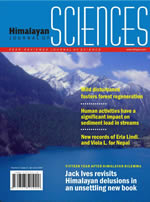Quantitative analysis of macrophytes of Beeshazar Tal, Chitwan, Nepal
DOI:
https://doi.org/10.3126/hjs.v2i3.229Keywords:
Oxbow lake, macrophytes, importance value index, species diversityAbstract
The authors undertook a quantitative investigation of aquatic macrophytes in Beeshazar Tal (Beeshazar Lake) in summer and winter of 2002 and spring of 2003. We found a distinct seasonal variation in the distribution of macrophytes: based on importance value index, Leersia hexandra Sw., Eichhornia crassipes (Mart.) Solms, Ceratophyllum demursum L. and Trapa quadrispinosa Roxb. were dominant in the summer; E. crassipes and Hydrilla verticillata (L.f.) Royle were dominant in the winter; and Ceratophyllum submersum L., H. verticillata, E. crassipes and L. hexandra were dominant in the spring. The highest species diversity was observed in the summer, followed by winter and then spring. The luxuriant growth of aquatic macrophytes evinced the highly productive nature of the lake, while the dominance of emergents among the growth forms indicates the encroachment of littoral vegetation, indicating a successional trend toward marsh meadow. Key words: Oxbow lake, macrophytes, importance value index, species diversity Himalayan Journal of Sciences 2(3): 37-41, 2004Downloads
Download data is not yet available.
Abstract
1525
PDF
1144
Downloads
How to Cite
Burlakoti, C., & Karmacharya, S. B. (2006). Quantitative analysis of macrophytes of Beeshazar Tal, Chitwan, Nepal. Himalayan Journal of Sciences, 2(3), 37–41. https://doi.org/10.3126/hjs.v2i3.229
Issue
Section
Research Papers




